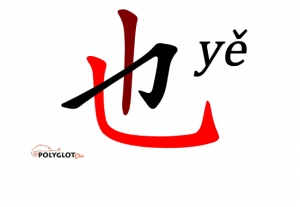Difference between revisions of "Language/Mandarin-chinese/Grammar/也-yě"
< Language | Mandarin-chinese | Grammar
Jump to navigation
Jump to search
m (Vincent moved page Language/Mandarin-chinese/Grammar/Meaning-adverb-也-yě to Language/Mandarin-chinese/Grammar/也-yě) |
|||
| Line 1: | Line 1: | ||
[[File:也-polyglot-club-wiki.png|thumb]] | [[File:也-polyglot-club-wiki.png|thumb]] | ||
The adverb <code>也</code> <yě> means | The adverb <code>也</code> <yě> means “too” or “also”. | ||
Like all adverbs in Chinese, <code>也</code> <yě> is placed before the verb. | Like all adverbs in Chinese, <code>也</code> <yě> is placed before the verb. | ||
| Line 7: | Line 7: | ||
==structure== | ==structure== | ||
<code>Subject + | <code>Subject + Adverb + Verb + Object</code> | ||
<code>Subject + 也 + Verb + Object</code> | <code>Subject + 也 + Verb + Object</code> | ||
*<span class="notranslate">他 <code>也</code> | *<span class="notranslate">他 <code>也</code> 是 法國人。/他 <code>也</code> 是 法国人。 ‹ Tā yě shì Fǎguórén. › </span> | ||
<blockquote>He is also French.</blockquote> | <blockquote>He is also French.</blockquote> | ||
